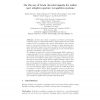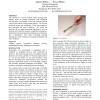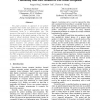WACV
2008
IEEE
14 years 6 months ago
2008
IEEE
deliver objects, handle emergency, wherever he/she is inside the home. In addition, the burden of processing We address issues dealing with distributed visual power can be distribu...
PERVASIVE
2010
Springer
14 years 6 months ago
2010
Springer
Activity and context recognition in pervasive and wearable computing ought to continuously adapt to changes typical of open-ended scenarios, such as changing users, sensor characte...
ICIAR
2009
Springer
14 years 6 months ago
2009
Springer
Abstract. Digital signage is a very attractive medium for advertisement and general communications in public open spaces. In order to add interaction capabilities to digital signag...
CHI
2003
ACM
14 years 12 months ago
2003
ACM
The XWand is a novel wireless sensor package that enables styles of natural interaction with intelligent environments. For example, a user may point the wand at a device and contr...
ICPR
2000
IEEE
15 years 21 days ago
2000
IEEE
This paper proposes an approach to 2D gesture recognition that models each gesture as a Finite State Machine (FSM) in spatial-temporal space. The model construction works in a sem...
ICPR
2002
IEEE
15 years 21 days ago
2002
IEEE
The scope of this paper is the interpretation of a user's intention via a video camera and a speech recognizer. In comparison to previous work which only takes into account g...
ICPR
2004
IEEE
15 years 21 days ago
2004
IEEE
Gesture recognition is a difficult task in computer vision due to the numerous degrees of freedom of a human hand. Fortunately, human gesture covers only a small part of the theor...
ICIP
1997
IEEE
15 years 1 months ago
1997
IEEE
This paper proposes a feature extraction method for gesture recognition, which is based on higher order local autocorrelation (HLAC) of PARCOR images. To extract dominant informat...
CVPR
2009
IEEE
15 years 6 months ago
2009
IEEE
Boosted one-versus-all (OVA) classifiers are commonly used in multiclass problems, such as generic object recognition, biometrics-based identification, or gesture recognition. Join...




